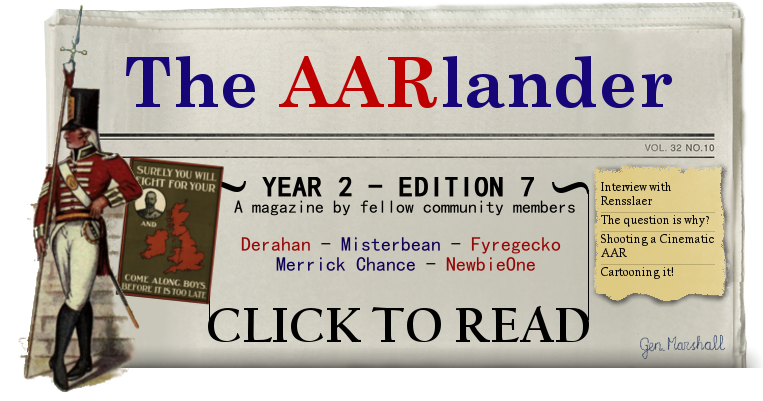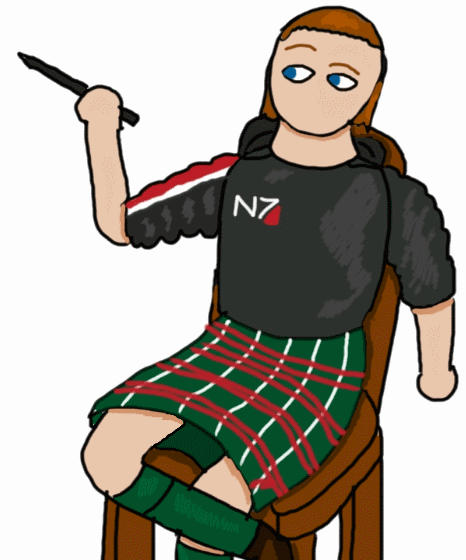Cartooning it!
by Fyregecko
Cartoons are fun. Most people who are reading this will either have read comics, or watched animated cartoons – I was going to say 'while growing up', but comics, in the form of graphic novels and webcomics, are entertainment for adults as well.
I've always liked cartoons. In hindsight, I wish that I had studied animation rather than the useless degree that I ended up with. But drawing, or at least idly doodling on the back of lecture notes, has always been one of my favourite activities – I can see the foundations of my 'style' of drawing when I look at old school and university work. Drawing a cartoon or comic myself is something that I love the idea of, but I've never believed that I had the requisite talent.
That changed, though, when I delved into the EUIII forums and started reading AARs. I enjoy writers in different genres and categories, but I have always been most attracted to comedy AARs, and knew that if I was to write one myself I would be trying the same thing. Plus, a gameplay AAR would make little sense from someone who isn't very good at EUIII. Writing an AAR gave me a receptive, helpful audience, and I'm very grateful to everyone who takes them time to read and comment on InTveresting Times, especially those who have been with it since the dark, early days of fighting for survival against the Golden Horde – without them, the AAR probably wouldn't exist anymore. I love performing for an audience, whether it's on-stage, voice work or writing, and always look forward to hearing people's reactions and thoughts on the latest episode.
It was around this time that I received a graphics tablet as a present. And I had the thought that, in the age of the internet, where millions of people put their content up for worldwide scrutiny, what harm would there be in trying to do what I'd wanted to do since I was a kid – draw a comic. But I didn't know if I had the discipline to create something new and keep it regularly updated, whether time pressure would turn it from a pleasure into a chore.
And that's where the AAR came in. Something that I was already working on, complete with a story (admittedly a lot of it written for me by the game), characters and a lovely, encouraging audience. I wanted to try out the tablet, I wanted to continue the AAR but was thinking of new ways to make it more distinctive...it was time for an experiment, and the good people of the forum were going to be the helpless animals mewling in pain. That is to say, beneficiaries.
The graphics tablet took a bit of getting used to, but the reaction was tremendous in spite of the very rudimentary quality of the early drawings (come on, they do get a
bit better...). Drawing the characters helped to develop them in my head, to give them more personality and ideas for ways in which they could interact with each other. The Dobczyñskis, long-suffering retainers of the House of Rurikovich and intended as the audience's 'man on the scene', changed from wearing distinctively Polish clothing and having brown hair in the earlier episodes, to a signature blood red cape and red hair (the latter starting with the half-Scottish Seamus Arkadiusz).
Originally intended to fulfil the role of audience surrogate (for those unfamiliar with the trope, to ask questions and provide a reason for the main characters to talk about the general situation), the Dobczyñskis developed into competent advisors and peerless soldiers with an appetite for smutty innuendo that has, I think, also become part of the AAR's 'feel' (trying not to sound too pretentious). They've also become increasingly attractive, partly because I enjoy drawing muscular men, and partly because I knew that I wanted Czarina Aleksandra,and later Czarina Maria to be (by my own tastes) beautiful and sexy, and didn't feel I would get away with it if male characters were not similarly idealised.
It's more the muscular men thing, though.
The Rurikoviches present a different challenge, both in narrative and in drawing. While I can mould the Dobczyñskis in whatever way I fancy, the Princes of Tver are always moulded partly, both in character and appearance, by their in-game stats and age at taking the throne. High-level Administrators, for example, tend to be awkward and geeky, good Diplomats are wo/manisers, and ones that have good Military and little else are barely-restrained bloodthirsty maniacs. Mikhael III, an unsurpassed 8/8/7, was based on the great Renaissance King of Scots James IV (including his penchant for art, palaces and exotic animals), while the recent Konstantin IV (3 / 4 / 5) took much inspiration – especially in his appearance - from the infinitely less capable George IV.
Their appearances vary much more than the Dobczyñskis, so it was important to give them something visual in common. Clothing would have worked, were it not for the second Prince, bear-wrestler Aleksandr II, with his penchant for not wearing anything other than a cape, an elaborate hat and, on special occasions, a pair of socks. I didn't want to make them wear crowns – not all, at least – since the style of crown varies greatly over different centuries, and I wanted the visual link to remain more-or-less the same throughout the AAR. So I settled for Aleksandr II's maroon cape as a universal symbol of Tverian sovereignty ('retconned' into his father's portrait). Later, as the heirs to the throne began to appear more in the illustrations, they also gained a distinctive sky blue cape echoing Tver's map colour. The capes, I think, are very effective in creating a distinctive look for the Princes of Tver, while allowing them to wear drastically different clothing appropriate to their personalities, time periods, or just the mood I was in the first time that I drew them.
The portraits of the Rurikoviches, found in the first post, nicely illustrate the development of my drawing style. The first on the page was actually done later, since I didn't have the tablet when Mikhael II was on the thone, but from Aleksandr II onwards the reader can see a progression: from trying to fit in with the style of the equestrian portrait it was adapted from, to the introduction of a black outline, to the stylisation of the characters' hands into circles to fit better with their minimalist faces (none of the characters display noses, and only very rarely show their teeth), to further use of black outlining around the eyes (which started out as Czarina Aleksandra's eyelashes and, even before that, the eyes and lashes of Pusia the tigress), small experiments with shading under Czarina Maria, and finally the current form with much more extensive shading and, I think, cleaner lines and better proportions.
Most of the story of InTveresting Times is about the Dobczyñskis and their interactions with this most powerful of Russian noble families. One set of characters whom I could create however I wanted, one partly dictated for me – overall, this made writing the story easier rather than harder, giving me lots of ideas for the development of new Rurikoviches. The drawings – probably the other most distinctive element of the AAR, though there are other cartoon-based ones out there (Selzro's excellent Subcontinental Subtleties, for instance, is a full comic rather than an illustrated narrative) – can take a surprising amount of work, and often add a few days to the production time of an episode, but I wouldn't drop them from the AAR for anything. This is particularly true when it is time for a new leader to take the reigns of power, or time for an advisor or family member to shuffle off this mortal coil. As at least one reader has noted, I enjoy death scenes. It's not always easy to come up with a new method of demise that suits the demisee (yes it is a word, because I say so) and once the comic goes out I frequently have other ideas and wish that I had done them a differently – but such is the life of the 'artist'.
AARland is a great source of gameplay tips and understanding of the mechanics of Paradox games. It's also a land of stories. Some detailed and historical. Some are tales of glory and success, others of miserable failure. Some are sad – and some are funny. I have tried to make InTveresting Times fit into the latter two categories, though more often aiming for comedy rather than tragedy. Not always with success, I feel – one of the most interesting parts of readers' comments is reactions to parts of the story that I thought I had either written/drawn especially well or in a rushed, slapdash, meet-the-deadline way. Frequently, an image I had hoped would tug at the viewer's heartstrings doesn't even get mentioned, but a throwaway linking paragraph receives a raft of compliments. It doesn't bother me as such, but does often surprise me. I'll admit that I sometimes felt disappointed when I felt that something I'd written didn't get the reaction I'd hoped for, but this is counterbalanced by unexpected praise. I can't speak for all writAARs and AARtists, but I definitely have an ego when it comes to readers' responses: most have made me happy, the occasional one quite sad. But the best part of all is the idea that, out there, there are lots of people willing to read InTveresting Times, and that, going by the comments, many of them enjoy it. And if I feel that the time spent writing and illustrating the AAR has brightened up a few people's day, then I feel that it's worth it.
Writing and updating AARs takes effort. Illustrating them, even mine which rarely has more than 2 or 3 images per update, takes even more. But I feel that the drawings give much greater depth and character to InTveresting Times: and my recent acquisition of a more responsive tablet (a Galaxy Note 10.1 for those who fancy a tablet computer that's good for drawing) has, I hope, enhanced this even further. It's not, of course, 'better' than other AARs, just written and presented in a different style. In AARland, some people want to learn how to be a brilliant player. Some want to read great stories of exploration and conquest. And some just want to have a laugh. As the writer of an illustrated AAR, I feel that it is my duty to serve the latter category, and I hope that, as I continue to grow and improve as an artist (I could hardly get any worse!), the very wonderful, supportive people of AARland will continue to provide me with encouragement, in return for a story, some drawings, and some very bad innuendo.
What could possibly go wrong?




